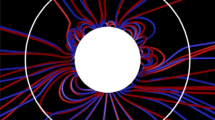Abstract
In this work we implement a new method for mapping the Sun's magnetic field B from the photosphere through the corona and interplanetary space. The method entails the derivation of B from a scalar potential within a ‘current-free’ annular volume bounded inside by the photosphere and outside by a prescribed non-spherical ‘source surface’ to which B is made (as nearly as possible) perpendicular. As usual we obtain the potential for the part of B that arises from currents inside the Sun by fitting an expansion to the observed line-of-sight component of B at the photosphere. The new aspect of our work is that we introduce a second least-squares fit to obtain the part of B that arises from currents outside the source surface. We do this by minimizing the mean-square tangential component of B over the source surface. This latter prescription allows a nearly arbitrary specification of the source surface, and no particular symmetry properties need be invoked for it. We have chosen as our prescription of the source surface one that reasonably simulates the expected physical consequences of coronal MHD effects. The magnetic field exterior to the source surface is made perpendicular to the source surface and is mapped throughout the heliosphere by means of a geometrical construction that appropriately generalizes the Parker spiral. Detailed comparisons have been made between this new model and observed coronal and interplanetary structures. The equatorward inclination of coronal helmet streamers is modeled much better with a non-spherical source surface than with a spherical one. There is clear evidence, however, that observational data underestimate the strength of photospheric polar magnetic fields. Neutral lines on the source surface (i.e., contours on which the normal component of B vanishes) generate heliospheric current sheets outside the source surface. In the particular case studied, two separate current sheets existed and were carried by the solar wind from the source surface to the boundary of the heliosphere. The result was a four-sector magnetic configuration near the ecliptic at 1 AU, and the observations were in good agreement with this prediction of the model.
Similar content being viewed by others
References
Adams, J., and Pneuman, G. W.: 1976, Solar Phys. 46, 185.
Altschuler, M. D. and Newkirk, G., Jr.: 1969, Solar Phys. 9, 131.
Altschuler, M. D., Levine, R. H., Stix, M., and Harvey, J. W.: 1976, Solar Phys. 51, 345.
Bohlin, J. D.: 1977, in J. B. Zirker (ed.), Coronal Holes and High Speed Solar Wind Streams, Colo. Assoc. Univ. Press, Boulder, pp. 27–69.
Burlaga, L. F., Behannon, K. H., Hansen, S. F., and Pneuman, G. W.: 1978, J. Geophys. Res. 83, 4177.
Howard, R.: 1977, Ann. Rev. Astron. Astrophys. 15, 153.
Hundhausen, A.: 1970, Rev. Geophys. Space Phys. 8, 729.
Jackson, B. V. and Levine, R. H.: 1981, Solar Phys. 73, 103.
King, J. H. (ed.): 1975, Interplanetary Magnetic Field Data, World Data Center A for Solar-Terrestrial Physics Report UAG-46, NOAA, Boulder, Colo.
Levine, R. H.: 1977, Astrophys. J. 218, 291.
Levine, R. H.: 1978, J. Geophys. Res. 83, 4193.
Levine, R. H. and Altschuler, M. D.: 1974, Solar Phys. 36, 345.
Levine, R. H., Altschuler, M. D., and Harvey, J. W.: 1977, J. Geophys. Res. 82, 1061.
Munro, R. and Jackson, B. V.: 1977, Astrophys. J. 213, 874.
Nerney, S. F. and Suess, S. T.: 1975, Astrophys. J. 196, 837.
Parker, E. N.: 1958, Astrophys. J. 128, 664.
Pneuman, G. W. and Kopp, R. A.: 1971, Solar Phys. 18, 258.
Poletto, G., Vaiana, G. S., Zombeck, M. V., Krieger, A. S., and Timothy, A. F.: 1975, Solar Phys. 44, 83.
Riesebieter, W. and Neubauer, F. M.: 1979, Solar Phys. 63, 127.
Schatten, K. H.: 1968, Nature 220, 1211.
Schatten, K. H., Wilcox, J. M., and Ness, N. F.: 1969, Solar Phys. 9, 442.
Schulz, M.: 1973, Astrophys. Space Sci. 24, 371.
Schulz, M., Frazier, E. N., and Boucher, D. J., Jr.: 1978, Solar Phys. 60, 83.
Smerd, S. F. and Dulk, G. A.: 1971, in R. Howard (ed.), ‘Solar Magnetic Fields’, IAU Symp. 43, 616.
Smith, S. and Schatten, K. H.: 1970, Nature 226, 1130.
Sturrock, P. A. and Smith, S. M.: 1968, Solar Phys. 5, 87.
Suess, S. T., Richter, A. K., Winge, C. R., and Nerney, S. F.: 1977, Astrophys. J. 217, 296.
Svalgaard, L., Duvall, T. L., Jr., and Scherrer, P. H.: 1978, Solar Phys. 58, 225.
Švestka, Z., Solodyna, C. V., Howard, R., and Levine, R. H.: 1977, Solar Phys. 55, 359.
Uchida, Y., Altschuler, M. D., and Newkirk, G. A., Jr.: 1973, Solar Phys. 28, 495.
Author information
Authors and Affiliations
Rights and permissions
About this article
Cite this article
Levine, R.H., Schulz, M. & Frazier, E.N. Simulation of the magnetic structure of the inner heliosphere by means of a non-spherical source surface. Sol Phys 77, 363–392 (1982). https://doi.org/10.1007/BF00156118
Received:
Issue Date:
DOI: https://doi.org/10.1007/BF00156118




